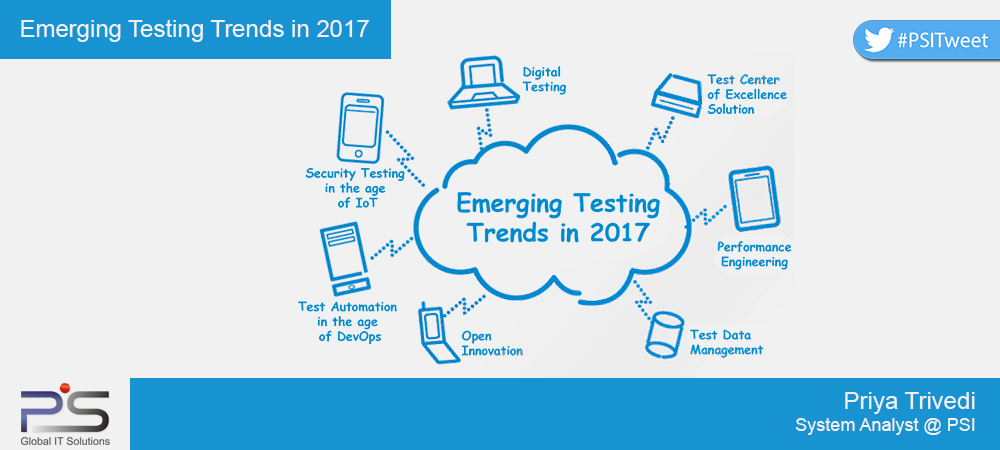Researchers suggest the global outsourced software testing market is poised to expand at a CAGR of 11% from 2016 to 2020. During the past few years, the software testing market has witnessed few diverse trends wherein the year 2015 brought a bandwagon trend of Agile and DevOps practices which were utilised by most organisations to reduce development time and cost involved. The next year, 2016 introduced new technologies with the Digital future looking imminent. And the year 2017 would start with the new challenging trend as ‘Prioritizing improvement initiatives’.
A testing team generally prepares an initial list for every year which they would like to work upon, however mostly use it whenever needed or planned tasks approach a due date.
Today we will discuss few important testing trends which should would be prevalent this year.
- Digital Testing: The exposure of digital technologies like Big Data, Cloud Computing, Mobile devices etc., has initiated the role of Digital testing in software testing. Faster releases, digital transformation speed, depletion of time-to-market life cycles are enhancing the importance of Quality Assurance and Testing for software development organizations.
- Test Center of Excellence Solution: Testing Center of Excellence (TcoE) is a robust framework that can be implemented in multiple phases with distinct key areas of every phase to enables organisations and establish strong quality processes and ensures reliability, availability and stability of applications. It also helps organisations maximise ROI from software testing through consolidation and standardization. It delivers higher customer satisfaction, employee engagements, high performance culture and higher job satisfaction among other things.
- Performance Engineering: It is also known as Software/System Performance Engineering (SPE) which is a systematic, quantitative and software oriented approach to focus on architecture, design, implementation choice and cost effective software development process to meet performance requirements on time and within budget.
- Test Data Management: The data drives the test procedure and test data management is fundamental process to optimise testing efforts and costs. In TDM process, tester first identifies the common test data elements, then performs aging, masking and archiving of test data, next prioritize and allocate test data to generate reports and dashboards for metrics. It is also helpful in creating and implementing business rules, building an automation suite for master data preparation, masking, archiving and versioning the aging of data.
- Open Innovation: Now a days, open source testing tools are in demand as developers can easily modify as per their project requirements and share because its design is publicly accessible. Open source technology and open source thinking benefits both the programmers and non-programmers. Its major features include reliability, stability, auditability, cost, flexibility and freedom, support and accountability.
- Test Automation in the age of DevOps: DevOps requires continuous testing. Testers act as functional tester cum business partner who verify requirements, own automation/continuous integration, which involves – configuring toolsets for continuous integration and delivery, build and tweak automation frameworks to support DevOps, implement, monitor and track continuous testing.
- Security Testing in the age of IoT: The Internet of Things (IoT) encloses any and all software/applications that are connected to the internet or to each other hence performance, security, compatibility & exploratory are four major IoT testing criteria. Major concern for a IoT project QA team is to set security priorities. Testers need to identify major threat areas web interface and user authentication processes in network-related concerns. Static and dynamic testing of IoT-connected devices should be performed thoroughly and ensure establishment of minimum baseline for security.
If a company is aligned with the latest technology trends, it enables stringent quality gates/check-points and improves processes rigor across software testing life cycle for their customers. All the above discussed trends coupled with independent testing ensures unbiased testing focus and improved product quality.Researchers suggest the global outsourced software testing market is poised to expand at a CAGR of 11% from 2016 to 2020. During the past few years, the software testing market has witnessed few diverse trends wherein the year 2015 brought a bandwagon trend of Agile and DevOps practices which were utilised by most organisations to reduce development time and cost involved. The next year, 2016 introduced new technologies with the Digital future looking imminent. And the year 2017 would start with the new challenging trend as ‘Prioritizing improvement initiatives’.
A testing team generally prepares an initial list for every year which they would like to work upon, however mostly use it whenever needed or planned tasks approach a due date.
Today we will discuss few important testing trends which should would be prevalent this year.
- Digital Testing: The exposure of digital technologies like Big Data, Cloud Computing, Mobile devices etc., has initiated the role of Digital testing in software testing. Faster releases, digital transformation speed, depletion of time-to-market life cycles are enhancing the importance of Quality Assurance and Testing for software development organizations.
- Test Center of Excellence Solution: Testing Center of Excellence (TcoE) is a robust framework that can be implemented in multiple phases with distinct key areas of every phase to enables organisations and establish strong quality processes and ensures reliability, availability and stability of applications. It also helps organisations maximise ROI from software testing through consolidation and standardization. It delivers higher customer satisfaction, employee engagements, high performance culture and higher job satisfaction among other things.
- Performance Engineering: It is also known as Software/System Performance Engineering (SPE) which is a systematic, quantitative and software oriented approach to focus on architecture, design, implementation choice and cost effective software development process to meet performance requirements on time and within budget.
- Test Data Management: The data drives the test procedure and test data management is fundamental process to optimise testing efforts and costs. In TDM process, tester first identifies the common test data elements, then performs aging, masking and archiving of test data, next prioritize and allocate test data to generate reports and dashboards for metrics. It is also helpful in creating and implementing business rules, building an automation suite for master data preparation, masking, archiving and versioning the aging of data.
- Open Innovation: Now a days, open source testing tools are in demand as developers can easily modify as per their project requirements and share because its design is publicly accessible. Open source technology and open source thinking benefits both the programmers and non-programmers. Its major features include reliability, stability, auditability, cost, flexibility and freedom, support and accountability.
- Test Automation in the age of DevOps: DevOps requires continuous testing. Testers act as functional tester cum business partner who verify requirements, own automation/continuous integration, which involves – configuring toolsets for continuous integration and delivery, build and tweak automation frameworks to support DevOps, implement, monitor and track continuous testing.
- Security Testing in the age of IoT: The Internet of Things (IoT) encloses any and all software/applications that are connected to the internet or to each other hence performance, security, compatibility & exploratory are four major IoT testing criteria. Major concern for a IoT project QA team is to set security priorities. Testers need to identify major threat areas web interface and user authentication processes in network-related concerns. Static and dynamic testing of IoT-connected devices should be performed thoroughly and ensure establishment of minimum baseline for security.
If a company is aligned with the latest technology trends, it enables stringent quality gates/check-points and improves processes rigor across software testing life cycle for their customers. All the above discussed trends coupled with independent testing ensures unbiased testing focus and improved product quality.[:]









